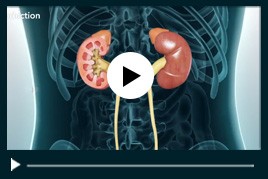Laparoscopic Urology
Laparoscopic urology involves treating the conditions of genitor-urinary tract using minimally invasive technique, the laparoscopy. The urology conditions may include the conditions affecting kidneys, ureter, bladder, penis & testes. Laparoscopy also known as keyhole surgery is the art of performing surgeries through the smaller incisions using tiny instruments or telescopic instruments. Laparoscope is a narrow tube with a camera and lens attached to it. The advantages of laparoscopic surgery over the traditional open incision surgery are minimal postoperative pain and bleeding, a short hospital stay, faster recovery, and fewer complications.
Advances in the field of medicine and technology enabled the physicians to perform laparoscopic surgeries to treat a wide range of urological conditions with better outcomes and minimal adverse events. Some of the commonly performed laparoscopic urology conditions include:
Laparoscopic simple or radical nephrectomy: A simple nephrectomy is the removal of one kidney whereas a radical nephrectomy also involves the removal of one kidney together with the neighbouring adrenal gland and lymph nodes. Laparoscopic nephrectomy is indicated in patients with kidney cancer, severe injury to the kidney, symptomatic hydronephrosis, chronic infection, polycystic kidney disease, shrunken kidney, hypertension or renal calculus.
Some risks of the procedure include injury to the neighbouring structures, kidney failure in the remaining kidney, temporary decrease in kidney function if only one kidney was removed, and hernias at incision sites.
Laparoscopic donor nephrectomy: It is the surgical removal of kidney for donation. This procedure is performed for the purpose of kidney donation.
The most serious donor complications that occur during laparoscopic donor nephrectomy include renal vessel injury, bowel injuries, bleeding or hematoma, and incisional hernias. The recipient complications include ureteral stenosis or leakage, vascular thrombosis, and allograft rejection.
Laparoscopic nephroureterectomy: It is a surgical procedure in which the surgeon removes the kidney and the ueter, the tube that carries urine from the kidney to the bladder. Laparoscopic nephroureterectomy is used to treat patients who have transitional cell carcinoma of the ureter or kidney.
Risks and complications of nephroureterectomy include infection, blood loss, and rarely injury to surrounding tissue and organs including bowel, lung, vascular structures, spleen, liver, pancreas and gallbladder. The procedure may require conversion to the standard open procedure if difficulty is encountered during the laparoscopic procedure.
Laparoscopic partial nephrectomy: It is a surgery to remove a diseased or damaged part of kidney.
Laparoscopic partial nephrectomy is performed in patients with a solid renal mass in a solitary kidney or compromised contralateral kidney, bilateral renal tumours, and in patients with a normal contralateral kidney with small localized renal tumours.
Risks and complications of laparoscopic partial nephrectomy include infection, blood loss, hernias at incision sites, urine leakage, and rarely injury to surrounding tissue and organs including bowel, lung, vascular structures, spleen, liver, pancreas and gallbladder. The procedure may require conversion to the standard open procedure if difficulty is encountered during the laparoscopic procedure.
Laparoscopic Pyeloplasty: It is a surgical procedure which relieves the obstruction between the ureter and the kidney at the ureteropelvic junction.
Laparoscopic pyeloplasty is indicated in patients with obstruction of ureteropelvic junction, junction where the ureter attaches to the kidney. Ureteropelvic junction (UPJ) obstruction can be caused by congenital anomaly (condition present at birth) such as horse shoe kidney, scarring from a past surgery, or a blood vessel which may cause UPJ to kink or a stone that gets impacted in the upper part of ureter. This may result in kidney tissue damage causing pain, kidney stones, infection, high blood pressure, impairment of kidney function, and kidney failure.
Risks of laparoscopic pyeloplasty include infection, blood loss, surgery failure, and injury to surrounding tissue and organs.
Laparoscopic Radical Prostatectomy: It is a surgical procedure to remove all of the prostate gland and some of the tissue around it. This procedure is effective in treating prostate cancer that has not spread beyond the prostate gland. This is called localized prostate cancer.
Risks and potential complications of laparoscopic radical prostatectomy include infection, bleeding, hernias at incision sites, difficulty controlling urine (urinary incontinence), erection problems, urethrovesical anastomotic leakage, and injury to surrounding tissue and organs including bowel, vascular structures, pelvic musculature, and nerves.
Laparoscopic Radical Cystectomy: It is a surgical procedure that is used to remove the bladder. Laparoscopic radical cystectomy is the treatment of choice for patients with muscle-invasive bladder cancer.
Complications related to the laparoscopic radical cystectomy include blood vessel injury, small rectal tear, subcutaneous emphysema, and hypercarbia (presence of too much carbon dioxide).

 Menu
Menu




